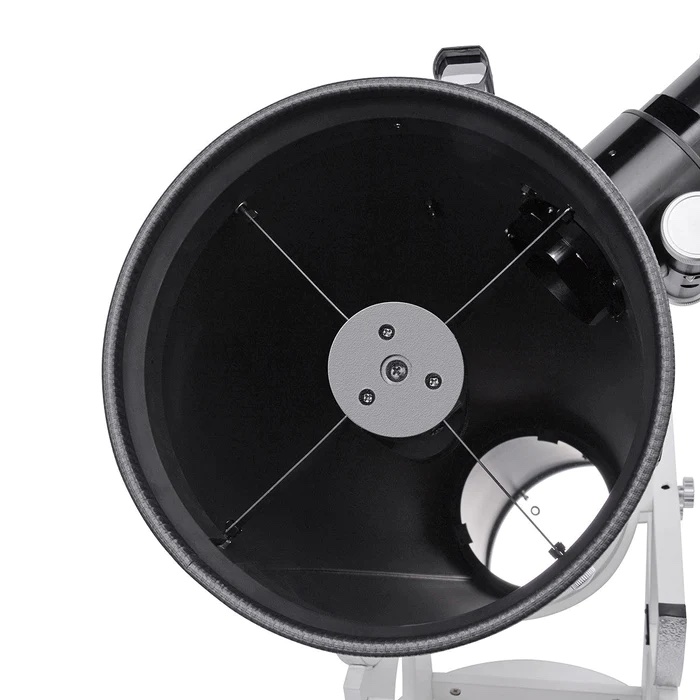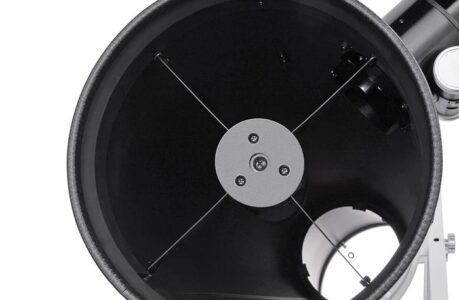When it comes to exploring the cosmos, few tools are as versatile and rewarding as a reflector telescope. With their exceptional light-gathering abilities and impressive magnification, reflector telescopes have been the go-to choice for amateur astronomers and stargazers for generations. In this comprehensive buyer’s guide, we will delve deep into the world of reflector telescopes, helping you make an informed decision and embark on a celestial adventure like no other.
Chapter 1: Understanding Reflector Telescopes
What is a Reflector Telescope?
A reflector telescope, also known as a Newtonian telescope, is a type of optical telescope that utilizes a combination of mirrors to collect and focus light. Unlike its counterpart, the refractor telescope, which uses lenses, a reflector telescope relies on precisely shaped mirrors to form images. This design offers several advantages, including reduced chromatic aberration and the ability to create larger apertures at a more affordable price point.
Key Components of a Reflector Telescope
Before delving into the buying process, it’s essential to understand the key components of a reflector telescope. These components play a crucial role in determining the telescope’s performance:
1. Primary Mirror: This is the largest mirror in the telescope and is responsible for gathering and reflecting light. Its quality and precision are paramount in determining image clarity.
2. Secondary Mirror: Positioned at an angle in front of the primary mirror, the secondary mirror reflects the light collected by the primary mirror toward the eyepiece or camera.
3. Focal Length: The distance between the primary mirror and the point where the light converges is known as the focal length. It determines the telescope’s magnification capabilities.
4. Aperture: The diameter of the primary mirror or objective lens defines the aperture size. A larger aperture collects more light and provides better image quality.
5. Mount: The mount holds the telescope and allows for precise tracking and adjustments. There are two main types: equatorial and altazimuth.
Now that you have a basic understanding of what makes up a reflector telescope, let’s explore the factors to consider when purchasing one.
Chapter 2: Choosing the Right Reflector Telescope
1. Aperture Size Matters
The most critical factor in choosing a reflector telescope is the aperture size. Aperture size directly impacts the telescope’s light-gathering ability, which, in turn, affects image brightness and clarity. When it comes to observing celestial objects, the larger the aperture, the better. Consider at least a 6-inch aperture for satisfying views of planets and deep-sky objects.
2. Focal Length and Magnification
The focal length of a reflector telescope determines its magnification capabilities. A longer focal length provides higher magnification but may limit your field of view. Shorter focal lengths are better suited for wide-field observations. Choose a focal length that aligns with your specific interests, whether it’s planetary observation or deep-sky imaging.
3. Mount Type
Selecting the right mount is crucial for stability and ease of use. Equatorial mounts are designed for precise tracking of celestial objects as they move across the sky. Altazimuth mounts are more straightforward but may require manual adjustments as objects drift. Consider your level of experience and how you plan to use the telescope when choosing a mount type.
4. Budget Considerations
Reflector telescopes come in a wide range of prices, making them accessible to various budgets. It’s essential to set a realistic budget based on your needs and expectations. Keep in mind that additional accessories such as eyepieces, filters, and a sturdy tripod may be necessary and should be factored into your budget.
5. Collimation
Collimation is the process of aligning the mirrors in your reflector telescope for optimal performance. While all telescopes require periodic collimation, some designs are more forgiving than others. Research the collimation process for the telescope you’re considering and assess whether you’re comfortable with it.
6. Portability and Storage
Consider how portable and easy to store your chosen reflector telescope is. If you plan to take it to dark-sky locations or travel with it frequently, a compact and lightweight design is preferable. Conversely, if it will mostly stay in one location, you can opt for a larger, more robust telescope.
Chapter 3: Top Reflector Telescope Models
Now that you understand the key factors to consider when purchasing a reflector telescope, let’s explore some of the top models available on the market.
1. Orion SkyQuest XT8 Classic Dobsonian Telescope

- Aperture: 8 inches
- Focal Length: 1200mm
- Mount: Dobsonian
The Orion SkyQuest XT8 is a classic Dobsonian reflector telescope known for its exceptional value and performance. With its 8-inch aperture and user-friendly Dobsonian mount, it’s an excellent choice for beginners and experienced astronomers alike. Its large aperture makes it ideal for deep-sky observations.
2. Celestron NexStar 6SE Telescope
- Aperture: 6 inches
- Focal Length: 1500mm
- Mount: Altazimuth
The Celestron NexStar 6SE is a versatile telescope with a 6-inch aperture and computerized altazimuth mount. It comes with Celestron’s SkyAlign technology for easy star alignment. This telescope is perfect for those interested in both planetary and deep-sky observation.
3. Sky-Watcher Collapsible Dobsonian Telescope
- Aperture: 10 inches
- Focal Length: 1200mm
- Mount: Dobsonian
The Sky-Watcher Collapsible Dobsonian Telescope features a generous 10-inch aperture and a collapsible design, making it easier to transport and store. Its large aperture ensures stunning views of galaxies, nebulae, and other deep-sky objects.
4. Meade Instruments LightBridge Mini 114mm Telescope

- Aperture: 4.5 inches
- Focal Length: 450mm
- Mount: Altazimuth
For those on a tight budget or seeking a portable option, the Meade Instruments LightBridge Mini 114mm Telescope offers a compact and affordable choice. While its aperture is smaller, it’s still capable of providing enjoyable views of the Moon, planets, and some deep-sky objects.
5. Explore Scientific FirstLight 8-inch Dobsonian

- Aperture: 8 inches
- Focal Length: 1200mm
- Mount: Dobsonian
The Explore Scientific FirstLight 8-inch Dobsonian is a solid choice for both beginners and experienced astronomers. Its generous aperture and stable Dobsonian mount make it a reliable option for exploring the wonders of the night sky.
Chapter 4: Accessories and Enhancements
To truly elevate your observing experience with a reflector telescope, consider the following accessories and enhancements:
1. Eyepieces
Investing in high-quality eyepieces allows you to customize your telescope’s magnification and field of view. Explore options with various focal lengths to suit different celestial objects.
2. Barlow Lens
A Barlow lens is a cost-effective way to double or even triple the magnification of your eyepieces. It’s a valuable tool for observing planets and lunar details.
3. Filters
Filters can enhance your views by reducing light pollution or enhancing specific colors. Narrowband filters, for example, are excellent for observing nebulae.
4. Red Dot Finder
A red dot finder makes it easier to align your telescope with celestial objects. It’s a valuable tool, especially for beginners.
5. Smartphone Adapter
Capture breathtaking images of the night sky with a smartphone adapter that allows you to attach your phone to the telescope’s eyepiece.
Chapter 5: Maintenance and Care
Cleaning Mirrors and Lenses
Regularly cleaning the mirrors and lenses of your reflector telescope is essential for maintaining image quality. Use a soft brush or compressed air to remove dust and debris, and follow manufacturer guidelines for cleaning solutions.
Collimation
Check and adjust the collimation of your telescope as needed. Many telescopes come with collimation tools, and there are various online tutorials to guide you through the process.
Storage
Store your telescope in a dry and secure location to protect it from dust, moisture, and potential damage. Cover it with a dust cap or a telescope cover when not in use.
Chapter 6: Where to Buy
When it comes to purchasing a reflector telescope, there are several reputable retailers and online stores to consider. Here are a few options:
- Telescope.com: Telescope.com offers a wide range of telescopes, including reflectors, along with accessories and expert advice.
- Celestron.com: Celestron is a well-known telescope manufacturer, and their website offers a variety of telescopes and accessories.
- Amazon: Amazon provides a vast selection of telescopes from various brands and sellers, making it a convenient option for buyers.
- Local Astronomy Clubs: Consider reaching out to your local astronomy club for recommendations and potentially purchasing from fellow enthusiasts.
Chapter 7: Conclusion
In conclusion, choosing the right reflector telescope is a rewarding journey into the world of astronomy. Whether you’re a beginner or an experienced stargazer, the key is to match your telescope to your specific interests and budget. With the right reflector telescope and accessories, you can unlock the wonders of the universe and embark on an incredible stargazing adventure.
As you explore the cosmos, remember that patience and practice are essential. The more you use your telescope, the more you’ll discover and appreciate the beauty of the night sky. Happy stargazing!

